Two Landscapes of Song for Treble Voices
1. Who Robbed the Woods 2. Cool is the Valley Now
-
Ships in 1 to 2 weeks
Details
Description
SKU: CF.CM9576
1. Who Robbed the Woods 2. Cool is the Valley Now. Composed by Paul David Thomas. Sws. Performance Score. 16 pages. Carl Fischer Music #CM9576. Published by Carl Fischer Music (CF.CM9576).ISBN 9781491153987. UPC: 680160912483. 6.875 x 10.5 inches. Key: G minor. English. Emily Dickinson (1830-1886) , Walt Whitman (1819-1892).
The two pieces, Who Robbed the Woods? and O Cool is the Valley Now, combine to create a set that both explores the subtle beauty, serenity, fragility, and resiliency of nature and examines our relationship to the natural world around us. The first song combines a short poem by Emily Dickinson with a journal entry excerpt by Walt Whitman entitled The Lesson of the Tree. Only two stanzas in length, Dickinsons poem considers the ways in which people use and exploit trees for their own purposes and asks, on the trees behalf, who would do such a thing? Whitman ponders a trees silent majesty and power and its ability to be yet say nothing at all. The musical setting begins and ends in the mode of G-Dorian while moving briefly in the middle section to Bb major. The Dorian mode, similar to the natural minor but with a raised sixth scale degree, possesses a mysterious and whimsical sound, fitting for a poem that considers the possibility of talking trees. The accents and syncopation of the piano accompaniment should be carefully observed, with particular attention paid to the syncopation found in gestures occurring in mm. 712. The beginning a cappella section should be hushed yet intense; a richer, fuller sound may be brought out in the middle section where the key shifts to Bb major and the choir sings of the many noble qualities of trees (mm. 3953). O Cool is the Valley Now also makes use of a modal scale. Set primarily in D Mixolydian, similar to D major but with a lowered seventh scale degree, this modes lack of a leading tone gives the melody a folk-tune quality. The piano should at all times remain legato and flowing, its ascending and descending gestures, found in mm. 910, imitating the rolling hills and valleys evoked in the text. The phrases of the vocal lines should also be flowing and carefully shaped. Additional rubato and dynamic subtleties may be added to accentuate any number of the suspensions and dissonances that occur, especially on p. 14.
The two pieces, aWho Robbed the Woods?a and aO Cool is the Valley Now,a combine to create a set that both explores the subtle beauty, serenity, fragility, and resiliency of nature and examines our relationship to the natural world around us. The first song combines a short poem by Emily Dickinson with a journal entry excerpt by Walt Whitman entitled The Lesson of the Tree. Only two stanzas in length, Dickinsonas poem considers the ways in which people use and exploit trees for their own purposes and asks, on the treesa behalf, who would do such a thing? Whitman ponders a treeas silent majesty and power and its ability to be ayet say nothing at all.a The musical setting begins and ends in the mode of G-Dorian while moving briefly in the middle section to Bb major. The Dorian mode, similar to the natural minor but with a raised sixth scale degree, possesses a mysterious and whimsical sound, fitting for a poem that considers the possibility of talking trees. The accents and syncopation of the piano accompaniment should be carefully observed, with particular attention paid to the syncopation found in gestures occurring in mm. 7a12. The beginning a cappella section should be hushed yet intense; a richer, fuller sound may be brought out in the middle section where the key shifts to Bb major and the choir sings of the many noble qualities of trees (mm. 39a53). O Cool is the Valley NowA also makes use of a modal scale. Set primarily in D Mixolydian, similar to D major but with a lowered seventh scale degree, this modeas lack of a leading tone gives the melody a folk-tune quality. The piano should at all times remain legato and flowing, its ascending and descending gestures, found in mm. 9a10, imitating the rolling hills and valleys evoked in the text. The phrases of the vocal lines should also be flowing and carefully shaped. Additional rubato and dynamic subtleties may be added to accentuate any number of the suspensions and dissonances that occur, especially on p. 14.
The two pieces, aWho Robbed the Woods?a and aO Cool is the Valley Now,a combine to create a set that both explores the subtle beauty, serenity, fragility, and resiliency of nature and examines our relationship to the natural world around us. The first song combines a short poem by Emily Dickinson with a journal entry excerpt by Walt Whitman entitled The Lesson of the Tree. Only two stanzas in length, Dickinsonas poem considers the ways in which people use and exploit trees for their own purposes and asks, on the treesa behalf, who would do such a thing? Whitman ponders a treeas silent majesty and power and its ability to be ayet say nothing at all.a The musical setting begins and ends in the mode of G-Dorian while moving briefly in the middle section to Bb major. The Dorian mode, similar to the natural minor but with a raised sixth scale degree, possesses a mysterious and whimsical sound, fitting for a poem that considers the possibility of talking trees. The accents and syncopation of the piano accompaniment should be carefully observed, with particular attention paid to the syncopation found in gestures occurring in mm. 7a12. The beginning a cappella section should be hushed yet intense; a richer, fuller sound may be brought out in the middle section where the key shifts to Bb major and the choir sings of the many noble qualities of trees (mm. 39a53). "O Cool is the Valley Now"A also makes use of a modal scale. Set primarily in D Mixolydian, similar to D major but with a lowered seventh scale degree, this modeas lack of a leading tone gives the melody a folk-tune quality. The piano should at all times remain legato and flowing, its ascending and descending gestures, found in mm. 9a10, imitating the rolling hills and valleys evoked in the text. The phrases of the vocal lines should also be flowing and carefully shaped. Additional rubato and dynamic subtleties may be added to accentuate any number of the suspensions and dissonances that occur, especially on p. 14.
The two pieces, "Who Robbed the Woods?" and "O Cool is the Valley Now," combine to create a set that both explores the subtle beauty, serenity, fragility, and resiliency of nature and examines our relationship to the natural world around us. The first song combines a short poem by Emily Dickinson with a journal entry excerpt by Walt Whitman entitled The Lesson of the Tree. Only two stanzas in length, Dickinson's poem considers the ways in which people use and exploit trees for their own purposes and asks, on the trees' behalf, who would do such a thing? Whitman ponders a tree's silent majesty and power and its ability to be "yet say nothing at all." The musical setting begins and ends in the mode of G-Dorian while moving briefly in the middle section to Bb major. The Dorian mode, similar to the natural minor but with a raised sixth scale degree, possesses a mysterious and whimsical sound, fitting for a poem that considers the possibility of talking trees. The accents and syncopation of the piano accompaniment should be carefully observed, with particular attention paid to the syncopation found in gestures occurring in mm. 7-12. The beginning a cappella section should be hushed yet intense; a richer, fuller sound may be brought out in the middle section where the key shifts to Bb major and the choir sings of the many noble qualities of trees (mm. 39-53). "O Cool is the Valley Now" also makes use of a modal scale. Set primarily in D Mixolydian, similar to D major but with a lowered seventh scale degree, this mode's lack of a leading tone gives the melody a folk-tune quality. The piano should at all times remain legato and flowing, its ascending and descending gestures, found in mm. 9-10, imitating the rolling hills and valleys evoked in the text. The phrases of the vocal lines should also be flowing and carefully shaped. Additional rubato and dynamic subtleties may be added to accentuate any number of the suspensions and dissonances that occur, especially on p. 14.
The two pieces, "Who Robbed the Woods?" and "O Cool is the Valley Now," combine to create a set that both explores the subtle beauty, serenity, fragility, and resiliency of nature and examines our relationship to the natural world around us. The first song combines a short poem by Emily Dickinson with a journal entry excerpt by Walt Whitman entitled The Lesson of the Tree. Only two stanzas in length, Dickinson's poem considers the ways in which people use and exploit trees for their own purposes and asks, on the trees' behalf, who would do such a thing? Whitman ponders a tree's silent majesty and power and its ability to be "yet say nothing at all." The musical setting begins and ends in the mode of G-Dorian while moving briefly in the middle section to Bb major. The Dorian mode, similar to the natural minor but with a raised sixth scale degree, possesses a mysterious and whimsical sound, fitting for a poem that considers the possibility of talking trees. The accents and syncopation of the piano accompaniment should be carefully observed, with particular attention paid to the syncopation found in gestures occurring in mm. 7-12. The beginning a cappella section should be hushed yet intense; a richer, fuller sound may be brought out in the middle section where the key shifts to Bb major and the choir sings of the many noble qualities of trees (mm. 39-53). "O Cool is the Valley Now" also makes use of a modal scale. Set primarily in D Mixolydian, similar to D major but with a lowered seventh scale degree, this mode's lack of a leading tone gives the melody a folk-tune quality. The piano should at all times remain legato and flowing, its ascending and descending gestures, found in mm. 9-10, imitating the rolling hills and valleys evoked in the text. The phrases of the vocal lines should also be flowing and carefully shaped. Additional rubato and dynamic subtleties may be added to accentuate any number of the suspensions and dissonances that occur, especially on p. 14.
The two pieces, “Who Robbed the Woods?” and “O Cool is the Valley Now,” combine to create a set that both explores the subtle beauty, serenity, fragility, and resiliency of nature and examines our relationship to the natural world around us.The first song combines a short poem by Emily Dickinson with a journal entry excerpt by Walt Whitman entitled The Lesson of the Tree. Only two stanzas in length, Dickinson’s poem considers the ways in which people use and exploit trees for their own purposes and asks, on the trees’ behalf, who would do such a thing? Whitman ponders a tree’s silent majesty and power and its ability to be “yet say nothing at all.”The musical setting begins and ends in the mode of G-Dorian while moving briefly in the middle section to Bb major. The Dorian mode, similar to the natural minor but with a raised sixth scale degree, possesses a mysterious and whimsical sound, fitting for a poem that considers the possibility of talking trees. The accents and syncopation of the piano accompaniment should be carefully observed, with particular attention paid to the syncopation found in gestures occurring in mm. 7–12. The beginning a cappella section should be hushed yet intense; a richer, fuller sound may be brought out in the middle section where the key shifts to Bb major and the choir sings of the many noble qualities of trees (mm. 39–53)."O Cool is the Valley Now" also makes use of a modal scale. Set primarily in D Mixolydian, similar to D major but with a lowered seventh scale degree, this mode’s lack of a leading tone gives the melody a folk-tune quality. The piano should at all times remain legato and flowing, its ascending and descending gestures, found in mm. 9–10, imitating the rolling hills and valleys evoked in the text. The phrases of the vocal lines should also be flowing and carefully shaped. Additional rubato and dynamic subtleties may be added to accentuate any number of the suspensions and dissonances that occur, especially on p. 14.
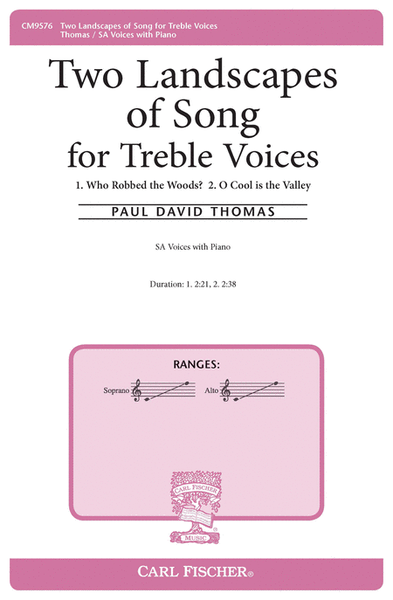
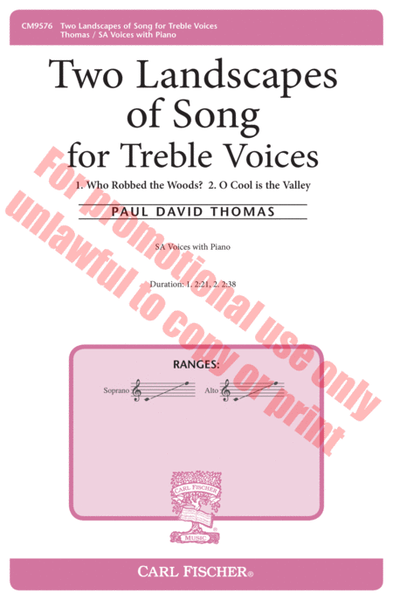
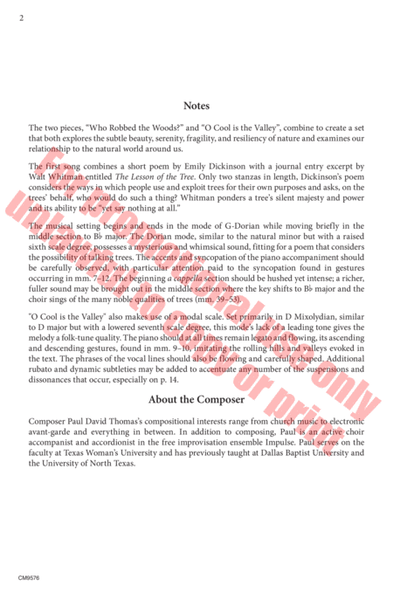
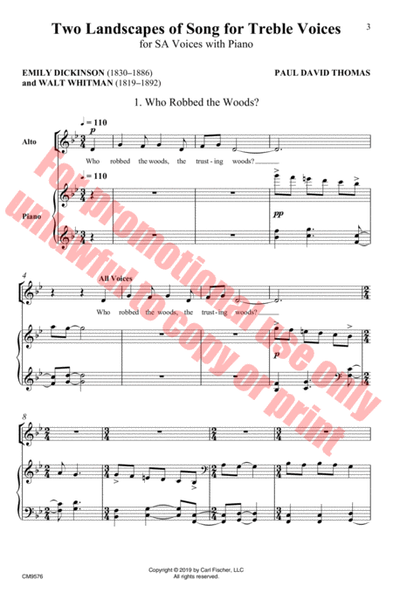
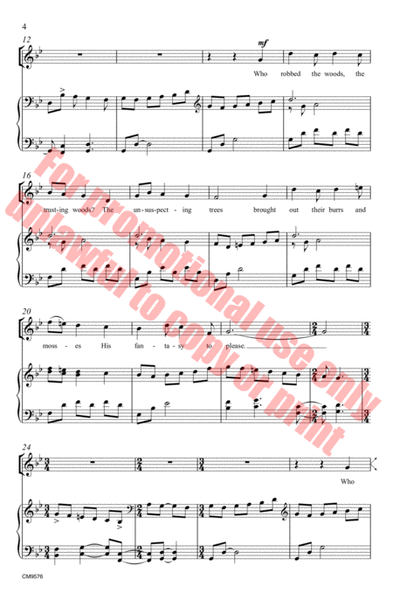
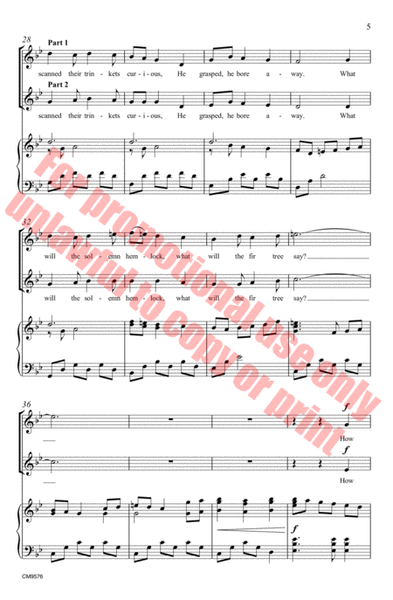
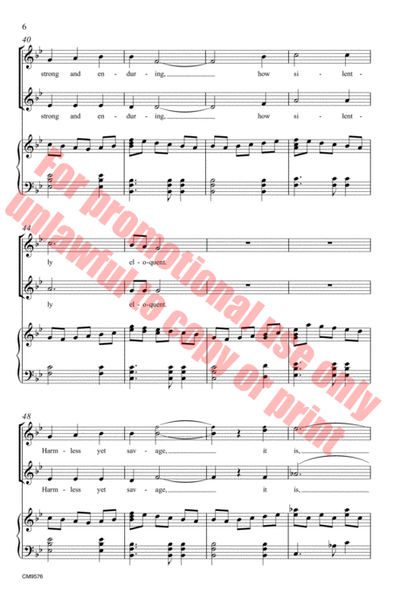
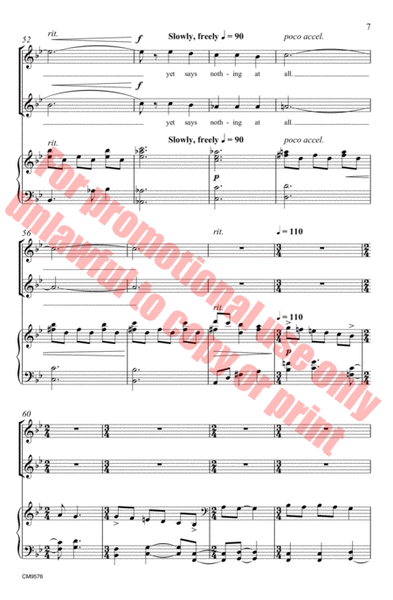
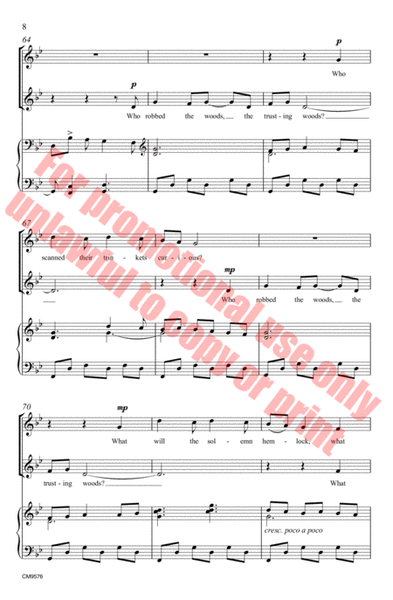

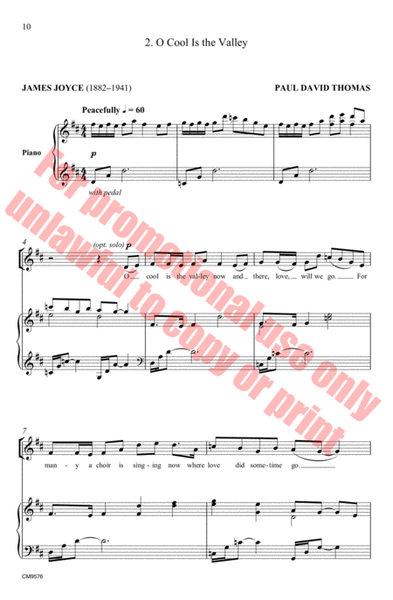
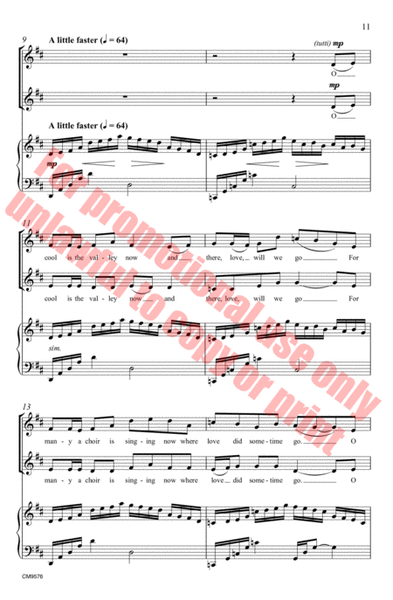
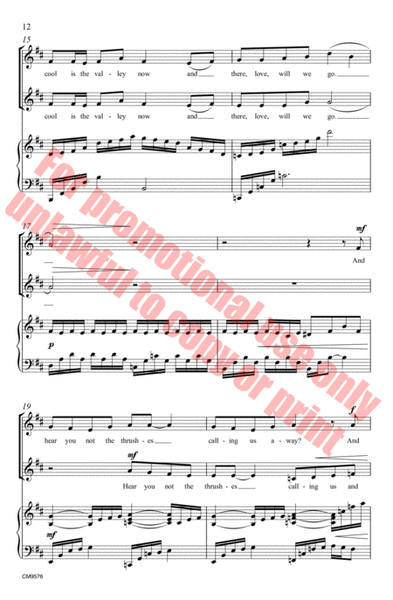
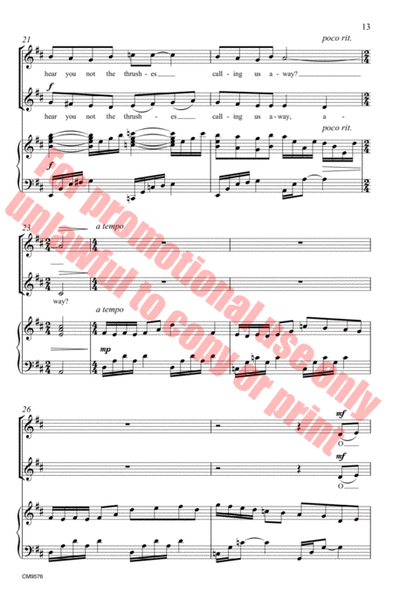
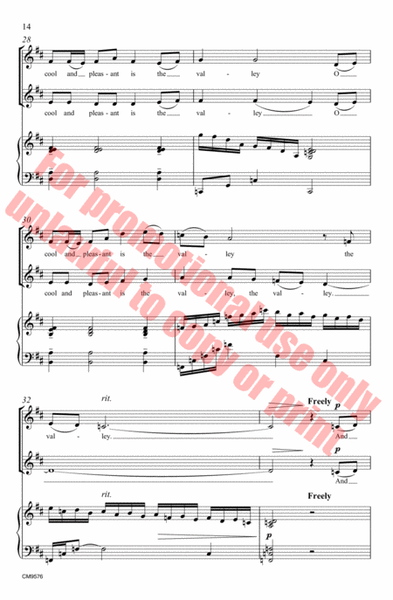
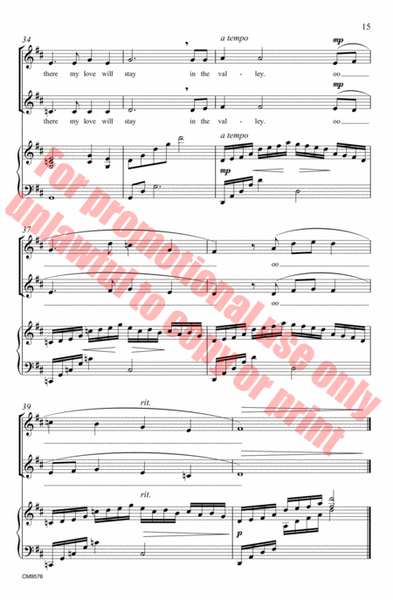
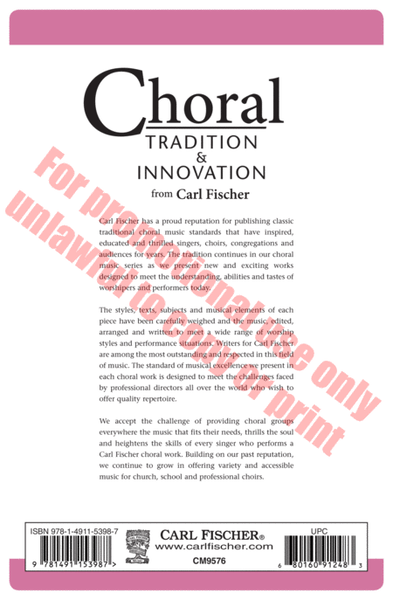
 Share
Share